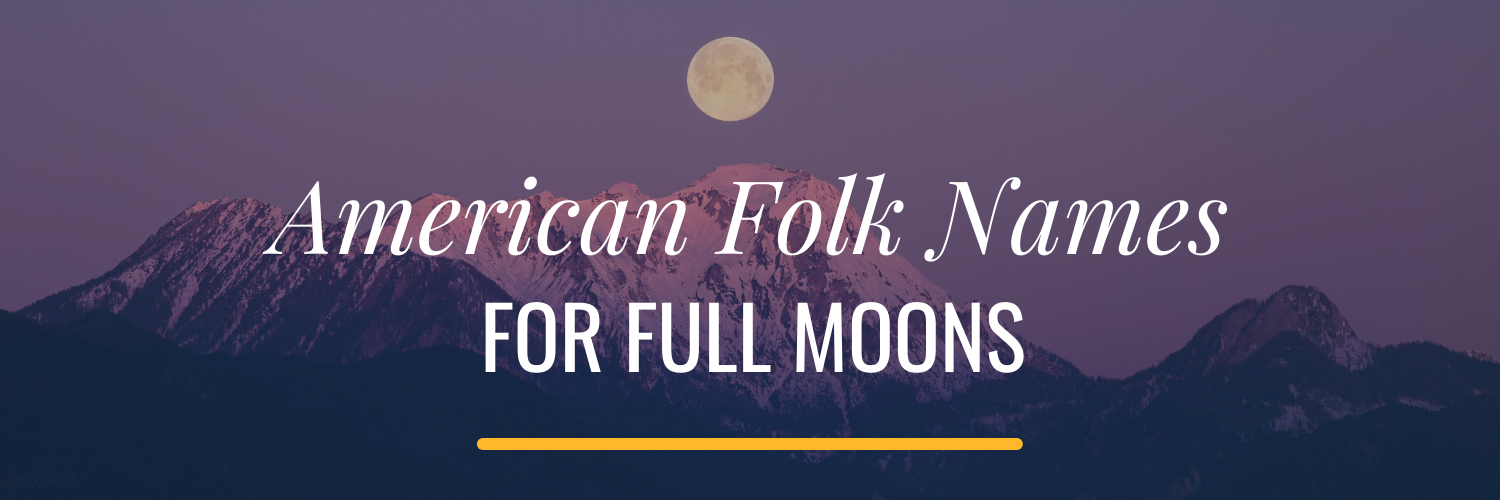Once upon a time, humanity kept time by the phases of the Moon. Our word “month” even comes from the word Moon. Full Moons were named after the qualities and events of the time of year they occurred, thus keeping us in tune with the cycle of seasons.
The common American folk names for Full Moons originated from the daily experiences of Native American tribes in the northeast. But, we could also follow in their tradition and devise contemporary names for the monthly full Moons.
Typically, the Full Moons were divided by season, with three Full Moons each quarter.
Winter Full Moons
Cold Moon (December)
December's Full Moon gets its name for the deepening grip of winter weather days. The name Long Night Moon pays homage to the Winter Solstice, the longest night of the year in the northern hemisphere. Europeans also called this the Moon before (or after) Yule. The Holiday Moon still shines over our ‘Tis-the-Season bustle.
Wolf Moon (January)
Wolves howled in the cold, snowy forests of January, giving lament to the long night. The New Year's Resolution Moon, the Holiday Exchanges Moon, or the Superbowl Moon might headline our list of 21st-century January moon names.
Snow Moon (February)
Late winter often brings the heaviest snows to the northeast region, inspiring the name Snow Moon. The last moon of winter was also called the Hunger Moon, for the food stores running low after months of cold. We might also celebrate this Full Moon with hearts and flowers as the Valentine's Moon. (Or, if you are in New Orleans, the Marti Gras Moon.)
Spring Full Moons
Worm Moon (March)
Spring is in the air during the March Full Moon, and it went by many names. Some called it the Sap Moon, for the sap rising in the trees; the Worm Moon, for the earthworms moving after the thaw; and the Crow Moon, for the return of birds after their winter migration. We might include the Spring Break Moon, March Madness Moon, or the Spring Cleaning Moon.
Pink Moon (April)
The Pink Moon is named after the pink phlox, the first flowers of spring. Some tribes also called it the Sprouting Grass Moon or the Egg Moon. We might favor the Easter Moon, the Earth Day Moon, or the Prom Night Moon. (We could also call it the Tax Moon, but that might not catch on.)
Flower Moon (May)
May's flowers also lent their name to this moon. It was also called the Planting Moon for sowing the seeds for the summer crop. Mom's Moon would be an appropriate tribute for Mother's Day, or Soldier's Moon, for Memorial Day.
Summer Full Moons
Strawberry Moon (June)
Strawberries ripen across the Northeast in June, giving this moon its name. It was known to Europeans as the Rose Moon, Bright Moon, or the Hare Moon. Our start of summer rituals might lend their names to June's Moon — Dad's Moon, Graduation Moon, Wedding Moon, or the Sun's Moon for the Summer Soltice that occurs toward the end of the month.
Thunder Moon (July)
The summer thunderstorms that raced across the July skies gave name to this moon. Other folk names included the Buck Moon, for the new antlers appearing on buck deer, or the Hay Moon, for the harvesting of hay fields. Today's Americans might call this the Fireworks Moon, the Liberty Moon, the Vacation Moon, or the Air-conditioning Moon.
Sturgeon Moon (August)
August was peak season for the sturgeon, a large fish found in the Great Lakes. The colonists also called this Full Moon, Red Moon, for its red-tinged hue from the summer haze, or the Dog Day's Moon, after the bright star Sirius (also called the Dog Star) high in the sky. To us, this could also be known as the Long-Summer Moon or the Barbeque Moon.
Autumn Full Moons
Harvest Moon (September)
The Harvest Moon is the Full Moon closest to the autumn equinox. The evening skies were brightly lit during the nights of the Full Moon, allowing farmers to work late in fields to harvest their crops. Even today, we still call this bright Full Moon the Harvest Moon, though we might add the Back-to-School Moon, the Homecoming Moon, or the Football Moon.
Hunter's Moon (October)
As leaves are changing colors, and tribes stored food for the winter, the Hunter's Moon (also called the Blood Moon) was an homage to the animals hunted in the thinning fields and forests. The Halloween Moon might be our name for this Full Moon, or perhaps the World Series Moon, for sports fans.
Beaver Moon (November)
Beaver Moon gets its name for the beavers and other animals preparing for the approaching winter. In honor of our annual turkey-day feast, today we might call this the Thanksgiving Day Moon, or even the Black Friday Moon.
Extra Bonus Moon
Blue Moon
Finally, when there are four Full Moons during the season, the “extra” moon was called a Blue Moon and traditionally inserted as the third of the season. Nowadays, it's more common to refer to a Blue Moon as the second Full Moon during a single calendar month. Either way, they occur about once every 2-1/2 years.
Get your Horoscope sent to your inbox every Sunday
Want to subscribe to The Astrology Hub Podcast? Find us on iTunes, Spotify, Stitcher, or TuneIn



